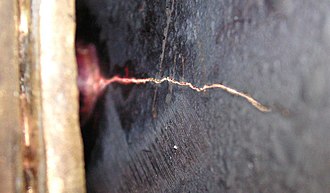Cupronickel





Cupronickel or copper-nickel is an alloy of copper that contains nickel and strengthening elements, such as iron and manganese. The copper content typically varies from 60 to 90 percent. The invention of cupronickel is dated back to the 19th century and it has been used for various applications due to its corrosion resistance, especially in marine environments, and its distinctive silver color.
Properties[edit]
Cupronickel alloys are known for their high resistance to corrosion in seawater, making them an ideal material for marine hardware, coinage, and seawater piping systems. The addition of nickel to copper improves its strength, durability, and resistance to corrosion and wear. These alloys also exhibit good thermal and electrical conductivity, though less than that of pure copper.
Composition and Grades[edit]
The most common grades of cupronickel are 90/10 (90% copper, 10% nickel) and 70/30 (70% copper, 30% nickel). The 90/10 alloy is commonly used where corrosion resistance is needed more than strength, while 70/30 is preferred for its higher strength and slightly better corrosion resistance. Other elements like manganese, iron, and zinc can be added to enhance specific properties.
Applications[edit]
Cupronickel's resistance to corrosion by seawater, as well as its aesthetic appeal, makes it a popular choice for coins. Many countries use cupronickel alloys in their higher-value coins. It is also used in marine engineering for piping, heat exchangers, and condensers because of its ability to withstand the corrosive effects of seawater. Additionally, it finds applications in desalination plants, offshore oil and gas platforms, and power generation.
History[edit]
The use of cupronickel can be traced back to the Chinese Qing dynasty and was later adopted by the British Admiralty in the 19th century for marine applications. The introduction of cupronickel in coinage began in the 20th century, with various countries adopting the alloy for its durability and resistance to wear and corrosion.
Environmental Impact[edit]
Cupronickel alloys are non-toxic and have a minimal environmental impact when used in marine environments. Their corrosion resistance ensures that they do not release harmful levels of copper or nickel into seawater, making them a sustainable choice for marine applications.
See Also[edit]
Ad. Transform your life with W8MD's Budget GLP-1 injections from $75


W8MD offers a medical weight loss program to lose weight in Philadelphia. Our physician-supervised medical weight loss provides:
- Weight loss injections in NYC (generic and brand names):
- Zepbound / Mounjaro, Wegovy / Ozempic, Saxenda
- Most insurances accepted or discounted self-pay rates. We will obtain insurance prior authorizations if needed.
- Generic GLP1 weight loss injections from $75 for the starting dose.
- Also offer prescription weight loss medications including Phentermine, Qsymia, Diethylpropion, Contrave etc.
NYC weight loss doctor appointmentsNYC weight loss doctor appointments
Start your NYC weight loss journey today at our NYC medical weight loss and Philadelphia medical weight loss clinics.
- Call 718-946-5500 to lose weight in NYC or for medical weight loss in Philadelphia 215-676-2334.
- Tags:NYC medical weight loss, Philadelphia lose weight Zepbound NYC, Budget GLP1 weight loss injections, Wegovy Philadelphia, Wegovy NYC, Philadelphia medical weight loss, Brookly weight loss and Wegovy NYC
|
WikiMD's Wellness Encyclopedia |
| Let Food Be Thy Medicine Medicine Thy Food - Hippocrates |
Medical Disclaimer: WikiMD is not a substitute for professional medical advice. The information on WikiMD is provided as an information resource only, may be incorrect, outdated or misleading, and is not to be used or relied on for any diagnostic or treatment purposes. Please consult your health care provider before making any healthcare decisions or for guidance about a specific medical condition. WikiMD expressly disclaims responsibility, and shall have no liability, for any damages, loss, injury, or liability whatsoever suffered as a result of your reliance on the information contained in this site. By visiting this site you agree to the foregoing terms and conditions, which may from time to time be changed or supplemented by WikiMD. If you do not agree to the foregoing terms and conditions, you should not enter or use this site. See full disclaimer.
Credits:Most images are courtesy of Wikimedia commons, and templates, categories Wikipedia, licensed under CC BY SA or similar.
Translate this page: - East Asian
中文,
日本,
한국어,
South Asian
हिन्दी,
தமிழ்,
తెలుగు,
Urdu,
ಕನ್ನಡ,
Southeast Asian
Indonesian,
Vietnamese,
Thai,
မြန်မာဘာသာ,
বাংলা
European
español,
Deutsch,
français,
Greek,
português do Brasil,
polski,
română,
русский,
Nederlands,
norsk,
svenska,
suomi,
Italian
Middle Eastern & African
عربى,
Turkish,
Persian,
Hebrew,
Afrikaans,
isiZulu,
Kiswahili,
Other
Bulgarian,
Hungarian,
Czech,
Swedish,
മലയാളം,
मराठी,
ਪੰਜਾਬੀ,
ગુજરાતી,
Portuguese,
Ukrainian


